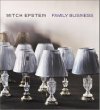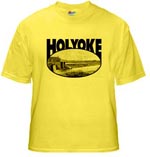by Laurel | September 14th, 2009
September 14, 1902, page 7
Cut was Made Last Night
New Telephone System Starts Off Successfully in New Building — Large Business of the Exchange.
In less than 45 seconds the 1200 subscribers of the Holyoke telephone system were transferred from the old system, where ringing was necessary, to the new system, where taking the receiver off the hook calls the operator at the central station. It was planned to make the transfer at 8 last evening, but the rain made trouble, and it was done at 9:32. At 9:25 a flying squadron of telephone operators tripped uo the stairs and into the dressing room, singing some appropriate stanzas about hands that were new. F. G. Daboll was stationed at the chief operator’s desk in the new room, and C. M. Pihl, the Holyoke manager, was at the old office. At 9:30 Mr. Daboll notified Mr. Pihl that all was ready at the new building, and the latter got in communication with the men in charge of cutting over. The “heating coils” were pulled out at the old office and word was sent over to the new office to cut in the new lines. The noise in the room suddenly quieted, and in a few seconds the first light flashed in the new switchboard — a call for 545-3. This was followed by another and another, and the waiting men of the construction force answered, finding all connections good, and in a few minutes the girls were given the positions, where they remained for some little time for practice. It was under 45 seconds from the time the old office was cut out and the new cut in to the first signal flash on the new board. Today the full force of firls will be at work to get them accustomed to the visual system, for in the new building a light shows when the subscriber calls central, in place of the familiar “tick-tick” and falling drop of the old system.
There were present at the “cut over” H. S. Hyde of this city, vice-president of the company, Dr. Parker of Lowell, member of the executive committee; Thomas C. Wales of Boston, chief engineer; George H. Dresser of Boston, general superintendent of construction (outside and inside)’ F. G. Daboll, district superintendent, of this city; M. Hutchins, superintendent of construction; C. M. Phil, local manager, and a few invited guests. The apparatus was installed by W. D. K. Taylor of Boston, who was also present.
The arrangement of the “positions” on the long “board” will be used to take care of lines in trouble, and will be in charge of the monitor, who will also have oversight of the local lines while the chief operator oversees the toll lines; the No. 1 position will be for the switching operator, who will receive the trunk line calls and transfer them where needed; the No. 2 position will be for Springfield; No. 3 for pay stations; No. 4 for six-party residence lines; Nos. 5 and 6 for measured service; Nos. 7 to 11 for unlimited service. There are 18 local positions, of which 12 are used and eight toll line positions, of which four are used. The chief operator and monitor have provate desks at the end of the operating room.
In 1892, when Holyoke had about 35,000 population, there were about 335 subscribers, while to-day, while the population has increased less than 33 1/3 per cent, the number of telephones has more than trebled, there being 1200 in use. The company has at present 2000 miles of wire underground, and 300 on poles. It employs 18 in place of nine employees. Of the 1200 telephones, 700 are business phones and 500 are residence phones. And it is believed by many that the business is yet in its infancy, and that in time to come the telephone will be considered as necessary to the average residence as the gas jet or the furnace.
The importance of Holyoke as a telephone city, standing as it does fourth in rank in New England, is due in great measure to its being a great paper mill center and having also many other important manufactures. An enormous amount of through or toll line business is done from Holyoke, at many of the mills an hour being set apart daily for “talking out of town.” Calls to the most distant points reached by the telephone are not uncommon, and Boston and New York talking is an every-day affair. In fact, the local lines cut but little figure as compared with the big amount of “trunk-line” work that is done to and from Holyoke. It has its effect on local service, for probably the company would hardly be able to afford to include Springfield and Chicopee in its unlimited telephone service were it not for the receipts from trunk line service.
The new building stands at the corner of Maple and Suffolk streets, and parallel with the latter street. It is build of light brick and two stories high, including a spacious basement with high ceiling. In this basement are the rooms for the repair and trouble men, regular construction gang, the engine and dynamos, etc. On the first floor at some distance from the street level are the public offices, the offices of the manager, cashier, book-keeper and collectors, and here are stationed three booths for pay station service. The operating-room is on the third floor and there are retiring rooms for the operators. The walls and ceilings are handsomely tinted and excellently finished.
From The Springfield Republican.








